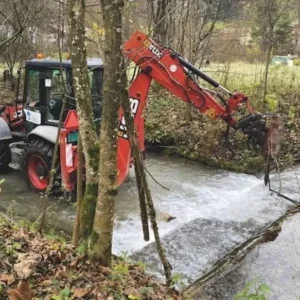TWO YEARS AGO, EBC Inc, a Quebec-based construction company, received a $68M contract to construct an 8.3km tunnel for hydro-quebec part of a 9.8km penstock tunnel that would carry water to turbines at a generating station about 120km north of Baie Comeau.
Guylaine Dubois is project manager for EBC on this venture. A ten-year employee and engineer, Dubois has managed a variety of EBC jobs over the years, but says the tunnel project (11m wide and 13m high) is her biggest challenge to date.
‘I think it’s also the longest tunnelling project that EBC has taken on,’ she adds. ‘And we’re not the only contractors at this site … we share it with three other companies, and there are about 700 people here. I have about 115 employees working, and with two 10-hour shifts per day, we try to stagger shift times so that we get almost 24-hour production.’
Reaching new heights
Three Axera T12 DATAs specially developed by Sandvik Tamrock are being used for this tunnel. They have been working underground since early summer two machines are always drilling as a team, side by side, with a third drilling the access tunnel and in less than two months after start-up had completed more than 600m of the tunnel.
These machines reach as high as 13m higher than any other jumbo in the world, according to the company. Dubois explains the significance of this: ‘Until Sandvik Tamrock made this new machine for us, the maximum height you could go was 12m. But we needed something special. We wanted to meet Hydro Quebec’s requirement of a 13m tunnel height, but do it with only one pass to save time and money.
‘Previously, all contractors were forced to build these tunnels in two stages,’ she explains. ‘The first pass would be 8m high, with regular jumbos drilling horizontally. Then, a contractor would have to remove all air, electricity and water services and go back to the start for a second pass of 5m of vertical drilling. It took a lot of time.’
For Sandvik Tamrock, the challenge was to build a machine with more flexibility and to make sure that it provided reliable service. The company has provided on site technical service, as well as all the rock drilling tools necessary for the completion of the project.
‘It’s not like the usual three-boom jumbo,’ Dubois explains. ‘It’s fully automated and instead of one operator for each boom the entire machine works with one operator. Each and every hole is accurately and automatically selected in the proper sequence, because we program it in advance.’
The Axera T12 DATA can be operated manually, if required, and works on a laser guidance system which means additional time savings because survey men are no longer required to mark the face between each round.
However, for Hydro Quebec the Axera T12 DATA has delivered an unexpected benefit and it all relates to the shape of the tunnel.
Historically these waterways have had flat floors, square corners, vertical sides and a roof cut in the shape of an arch. This resulted from the traditional two-stage process of construction. Using the Axera T12 DATA, EBC can build a tunnel using horizontal drilling only. That means the walls and roof are much smoother and water flows with less resistance and turbulence. The flexibility of the machine also allows the construction of a tunnel that is more oval in shape above the flat floor, meaning less turbulence and lower resistance to water flow. That means more power generation.
Related Articles
Spotlight on… Canada






